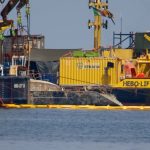UK tech tycoon Mike Lynch and his daughter were among seven killed when vessel sank during storm last August
Mike Lynch’s superyacht, Bayesian, has been resurfaced for the first time since it sank during a violent storm off the coast of Sicily in August last year, killing seven people including the tech tycoon and his teenage daughter.
The white top and blue hull of the 56-metre (184ft) vessel emerged from the depths of the sea in a holding area of a yellow floating crane barge, as salvage crews readied it to be hauled ashore for further investigation. The Italian coastguard said the recovery was scheduled to begin on Saturday morning.
A spokesperson for TMC Maritime, which is conducting the recovery operation, said the vessel had been slowly raised from the seabed, 50 metres (165ft) down, over the past three days to allow the steel lifting straps, slings and harnesses to be secured under the keel.
The operation – which has cost approximately $30m (£22m) – was made easier after the vessel’s 72-metre mast was detached using a remote-controlled cutting tool and placed on the seabed on Tuesday.
The vessel will be transported to the port of Termini Imerese, where investigators are expected to examine it as part of an inquiry into the cause of the sinking.
A digest of the morning's main headlines from the Europe edition emailed direct to you every week day
The Bayesian was anchored just offshore near the port of Porticello, in the province of Palermo, when it sank during a violent storm shortly before dawn on 19 August 2024.
Lynchhad beencleared two months earlier of fraud chargesin the US relating to the purchase of his company,Autonomy, by Hewlett-Packard in 2011, and was enjoying a voyage around Sicily to celebrate with his 18-year-old daughter, Hannah, and his wife, Angela Baraces, whose company owned the Bayesian.
The lawyer Chris Morvillo and his wife, Neda, the banker Jonathan Bloomer and his wife, Judy, and the yacht’s chef, Recaldo Thomas, were also killed when the vessel sank. Nine other crew members and six guests – including Baraces – were rescued.
The salvage operation was very complex, and was temporarily suspended in mid-May after Rob Cornelis Maria Huijben, a 39-year-old Dutch diver, died during underwater work.
The British-based consultancy TMC Marine, which oversaw a consortium of salvage specialists undertaking the project, said the hull would be lifted on to a specially manufactured steel cradle on the quayside once it had been transported to Termini Imerese.
Investigators hope the yacht will yield vital clues to the causes of the sinking. A forensic examination of the hull will seek to determine whether one of the hatches remained open and whether the keel was improperly raised.
Prosecutors have opened an inquiry into suspected manslaughter. The boat’s captain, James Cutfield, from New Zealand, and two British crew members,Tim Parker Eaton and Matthew Griffiths, have been placed under investigation. InItaly, this does not imply guilt or mean that formal charges will necessarily follow.
According to a preliminary safety report released last month by the UK’s Marine Accident Investigation Branch, the Bayesian may have been vulnerable to high winds when running on its engine and that these “vulnerabilities” were “unknown to either the owner or the crew” as they were not included in the stability information book carried onboard.
The MAIB said a possible “tornadic waterspout” headed towards the boats in the harbour. The docks seemed to divert the whirlwind, which went straight towards the Bayesian, and the vessel sank in the space of a few seconds.
In September, Italian authorities requested additional security around the wreck of the Bayesian, after fears were raised that material in watertight safes onboard might be of interest to foreign governments.

